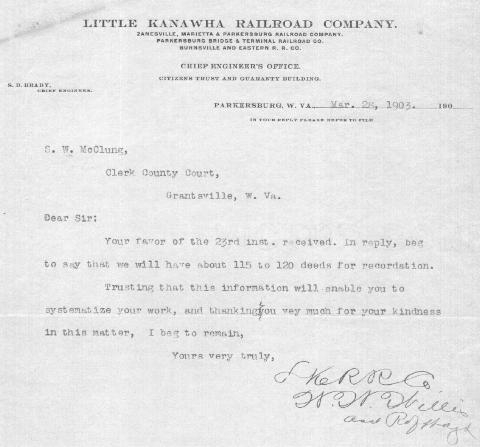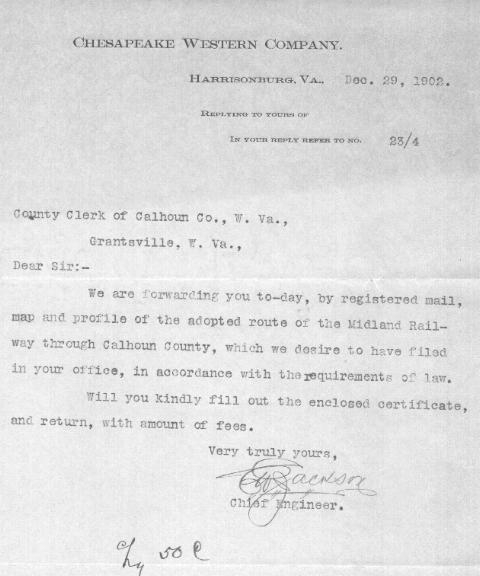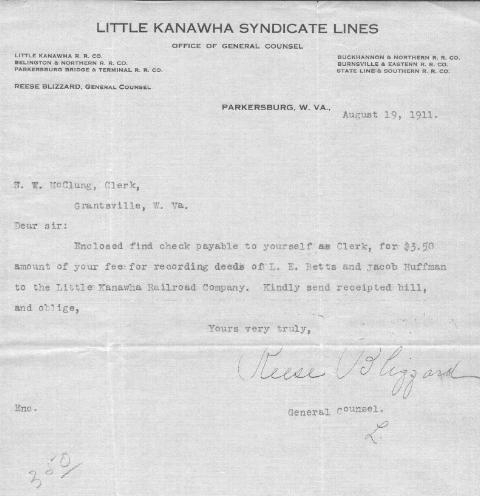PUFF PUFF, CHUG CHUG, CHOO CHOO - Millions Lost In LK Railroad Collapse(Part Two)
This is a further written account from newspaper and court records about the railroad that was never built.
 LK Railroad letter stating 115-120 right-of-way deeds need recorded
LK Railroad letter stating 115-120 right-of-way deeds need recorded- Transcribed by Norma Knotts Shaffer from microfilm of the Calhoun Chronicle dated 7/21/1896, 8/4/1896 and 8/11/189 and County Court Proceedings that convened Monday July 13, 1896 with G. Johnson, President; and T.R. Stump and B.F. Sturm, Commissioners
Upon the petition of sundry citizens in the districts of Sheridan, Center and Sherman, a special election was ordered to be held at various voting places in each district on a proposition to subscribe to the Little Kanawha River Railroad. In Sheridan District, $7,000; Center, $8,400; Sherman, $8,600. Said election to be held August 18, 1896. The levy passed in support of the railroad.
8/4/1896 - In this county some people are kicking because the proposed railroad subscription was not submitted to the whole county, and in Gilmer some are kicking because it was not submitted by districts. If the kickers of the two counties were together wouldn't there be a kickin' time.
8/11/1896 - The railroad subscription carried in Gilmer Saturday with a grand majority. The majority against it at Normantown was only 29, and at Glenville out of 204 votes but two were against it. The vote all over the county was about as decisive for the proposition, and our sister county, Gilmer, is entitled to put long streamers to her banner and have written thereon, "On to Progress." Following is the result:
Center district - For, 577; against, 170
Glenville - For 577; against 11
Dekalb - For 292, against, 10
Troy - For, 190; against, 150.
8/25/1896 - The following table shows how faithfully our voters performed their duty to the proposition to subscribe to the railroad. At Grantsville and White Pine, where the Chronicle has the greatest circulation, but one vote was cast against the proposition at the former and it was unanimous at the later. The voters at all of the voting places did themselves proud.
We can truthfully say we are a progressive people:
Sheridan District: Freed, 53 for and 18 against; Brooksville, 133 for and 111 against; Majority in District for R.R., 157
Center District: Chestnut Grove, 105 for and 4 against; Grantsville, 156 for and 1 against; Majority in District for R.R., 256
Sherman District: Sharp's Mill, 110 for and 5 against; White Pine, 144 for and 0 against; Majority in District for R.R., 249

This letter appears to be an effort to "take over"
the operations of the LK Railroad

Letter requesting the recording of rights-of-way
through L. E. Betts and Jacob Huffman
RAILROAD MONEY FOR LITTLE KANAWHA RAILROAD FALLS THROUGH
Washington, D.C. (About 1912) - The story of how $5,000,000 were spent the Little Kanawha valley in the construction of what was intended to be one link of a transcontinental railroad; how the failure to obtain funds necessary; the abandonment of the work, and the diversion of what funds could be obtained to the construction of a short railroad south from Pittsburg to tap northern West Virginia and Pennsylvania coal land; and how the coal in the upper Little Kanawha valley has largely passed into the hands of persons not interested in the extension of the Little Kanawha Railroad, was told by witnesses before Chairman Harlan of the interstate commerce commission today.
The hearing was on Senator Chilton's resolution for an investigation as to the ownership of the Little Kanawha Railroad and the intention of its owners regarding its extension.
Joseph Ramsey, organizer of the Little Kanawha syndicate and formerly right hand man for the Gould; Colonel J.T. Blair, former president of the Little Kanawha railroad; S.D. Brady, chief engineer of the same road; H.C. Jackson of New York; Hugh L. Bond, of the Baltimore and Ohio railroad, and others were before the commission.
Mr. Ramsey testified that he, William E. Guy and George J. Gould composed the syndicate managers of the syndicate which purchased the road; that they intended to construct a line from Zanesville, Ohio, by way of Parkersburg, to a connection with what was then the West Virginia Central, near Belington, but that they intended to ship coal to the west only.
George J. Gould subscribed $2,000,000 to the syndicate; Davis and Elkins the same amount, although they did not take all the stock they agreed to take, while many other persons made up the rest of the $7,500,000 with which it was intended to build the connecting link in the transcontinental line.
After about $5,000,000 had been spent it was found the work could not be completed for what they had, and it was abandoned, all of the available funds being used then to build the line south from Pittsburg.
Then Colonel J.M. Schoonmaker became interested in the property and parties represented by him bought the Little Kanawha Syndicate for $8,500,000, which merely netted the stockholders interest on the amount put in. He told how he helped Elkins and Davis to get $20,000,000 for the West Virginia Central, when they had been about to sell for $18,000,000.
W.W. VanWinkle and Joseph Ramsey told of the purchase by R.C. Kerens, H.G. Davis and S.B. Elkins of thousands of acres of coal lands in the Little Kanawha valley and of their interest in shipping it eastward over their own railroad rather than west through the Little Kanawha valley.
Colonel Blair said it had been in his hands for nearly two years, and that several times in that period he thought the road was sold, once having been sent for to come to New York to accept an initial payment of $500,000 on the purchase; that it had fallen through.
He said there is now a New York party negotiating for it and that parties represented by Sam A. Hars, of Parkersburg, are also considering its purchase.
He insisted that there has been no intention of preventing the development of the Little Kanawha valley, but that the present owners did not feel that the business of the valley would justify the expenditure of several million dollars to extend the road.
He did not think the extension to the coal lands could be profitably constructed and operated without direct connection to the lands, although he thought there might be a chance to market the coal by making Parkersburg a shipping point, taking coal there by rail and loading it there for shipment by water.
He said the Little Kanawha road had been operated by its present owners at $2,000 a month.
He said the property of the Little Kanawha syndicate known as the Buckhannon and Northern, and the coal holdings in the northern part of the state and in Pennsylvania, are now for sale and that the purchase of the entire holdings of the company, including the Little Kanawha road, was mainly to get hold of his part of the property which is not now desired to sell.
S.D. Brady, chief engineer for the Little Kanawha syndicate since 1901, testified that he believed not more than 20,000 acres of coal could be made available for the Little Kanawha road if built along the proposed line.
He said there are about 125,000 acres in the Little Kanawha coal basin, but that 45,000 acres is held by owners of the Coal and Coke road and could be shipped over their road, and that the largest part of the Little Kanawha holdings lies close to the Baltimore and Ohio, some of it as close as six miles, and could be shipped by Weston and Clarksburg to better advantage than on the Little Kanawha valley, where it would take twenty-five miles of branch road to reach it.
He said the tonnage is not in sight to justify the expenditure necessary to extend the Little Kanawha road and put it in shape to compete with other railroads.
Mr. Brady estimated that it would cost $200,000 to connect the Little Kanawha with the Baltimore and Ohio at Parkersburg and $350,000 to reconstruct the road and put it in shape for hauling coal.
He was of the opinion that it would take about $5,000,000 to extend the Little Kanawha railroad as planned, and put it in good shape for heavy hauling.